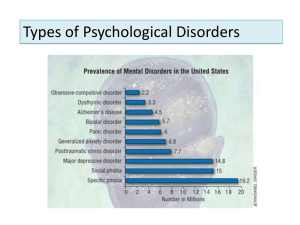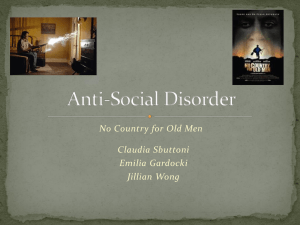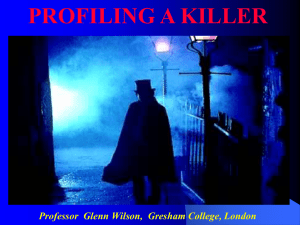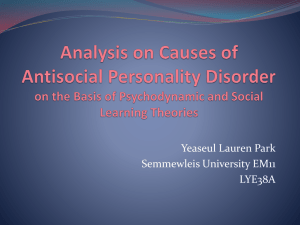File - Mr. May`s Class
advertisement
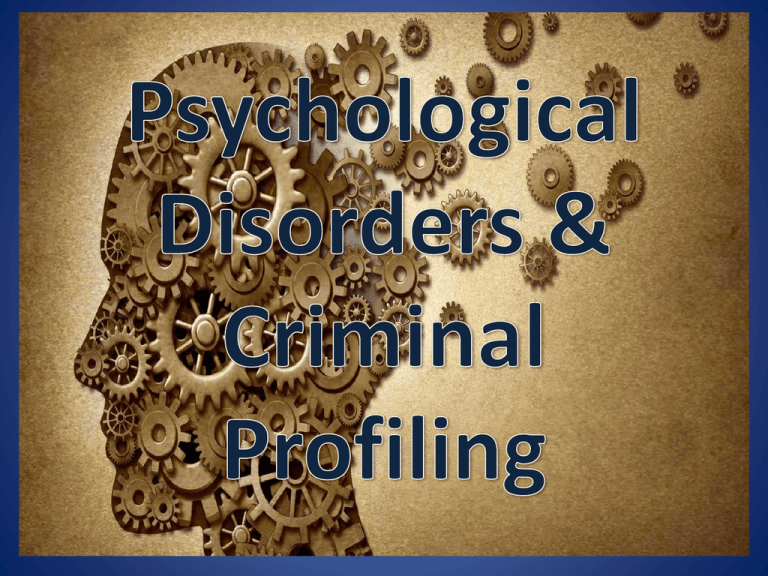
Psychopathological Triad There are three more important characteristics (behavioral red flags) often referred to as the psychopathological triad. And those are: Psychopathological Triad • Bed-Wetting – enuresis • There’s nothing unusual or alarming about bed-wetting in itself; it’s a common phenomenon among little children. When the problem persists into puberty, however, it may well be a sign of significant and even dangerous emotional disturbance. According to the findings of the FBI’s Behavioral Science Unit, fully 60 percent of sex-murderers were still suffering from this condition as adolescents. Psychopathological Triad • Fire-Starting – pyromania • Given their lust for destruction, it’s no surprise that, among their other twisted pleasures, many serial killers love to set fires, a practice they often begin at an early age. Some of the most notorious serial killers of modern times were juvenile arsonists. Psychopathological Triad • Fire-Starting – pyromania • David Berkowitz- who ultimately confessed to more than fourteen hundred acts of arsonwas so obsessed with fires as a little boy that his schoolmates nicknamed him “Pyro.” He is more commonly known as the “Son of Sam”. Psychopathological Triad • Animal Torture – precocious sadism • Juvenile sadism directed at lower life-forms is another component of the triad, which involves abuse and/or torture merely for pleasure. Psychopath Vs. Sociopath Psychopath Vs. Sociopath Psychopath Vs. Sociopath Antisocial Personality Disorder (APD) • Antisocial personality disorder is characterized by a long-standing pattern of a disregard for other people’s rights, often crossing the line and violating those rights. It usually begins in childhood or as a teen and continues into their adult lives. • Antisocial personality disorder is often referred to as psychopathy or sociopathy in popular culture. However, neither psychopathy nor sociopathy are recognized professional labels used for diagnosis. Symptoms of Antisocial Personality Disorder (APD) • Antisocial personality disorder is diagnosed when a person’s pattern of antisocial behavior has occurred since age 15 (although only adults 18 years or older can be diagnosed with this disorder) and consists of the majority of these symptoms: Symptoms of Antisocial Personality Disorder (APD) • Failure to conform to social norms with respect to lawful behaviors as indicated by repeatedly performing acts that are grounds for arrest • Deceitfulness, as indicated by repeated lying, use of aliases, or conning others for personal profit or pleasure • Impulsivity or failure to plan ahead • Irritability and aggressiveness, as indicated by repeated physical fights or assaults • Reckless disregard for safety of self or others • Consistent irresponsibility, as indicated by repeated failure to sustain consistent work behavior or honor financial obligations • Lack of remorse, as indicated by being indifferent to or rationalizing having hurt, mistreated, or stolen from another. Multiple Personality Disorder (MPD) • Multiple personality disorder (MPD) is a psychiatric disorder characterized by having at least one “alter” personality that controls behavior. The “alters” are said to occur spontaneously and involuntarily, and function more or less independently of each other. The unity of consciousness, by which we identify our selves, is said to be absent in MPD. Multiple Personality Disorder (MPD) • In order to understand multiple personality it is first important to eliminate a popular misconception. Many people confuse multiple personality with schizophrenia. However, schizophrenia is an entirely different disorder and does not have anything to do with multiple personality. One characteristic of schizophrenia is a “split” between thinking and affect (feelings) which results in an inappropriate expression of affect. Multiple Personality Disorder (MPD) • The basic idea is that the person deals with conflicting feelings and thoughts by repressing them and compartmentalizing them so that certain kinds of feelings and thoughts are expressed in one personality or state of consciousness, and other conflicting feelings and thoughts are expressed in another personality. • This creates two separate “people”. Multiple Personality Disorder (MPD) • There is general agreement that the cause of MPD is repressed memories of childhood abuse. The evidence for this claim has been challenged, however, and there are very few reported cases of MPD afflicting children. • MPD can be used to explain behavior, but not excuse it. What Is Schizophrenia? • Schizophrenia is a chronic, severe, and disabling brain disorder that has affected people throughout history. • People with the disorder may hear voices other people don't hear. They may believe other people are reading their minds, controlling their thoughts, or plotting to harm them. This can terrify people with the illness and make them withdrawn or extremely agitated. What Is Schizophrenia? • People with schizophrenia may not make sense when they talk. They may sit for hours without moving or talking. Sometimes people with schizophrenia seem perfectly fine until they talk about what they are really thinking. • Families and society are affected by schizophrenia too. Many people with schizophrenia have difficulty holding a job or caring for themselves, so they rely on others for help. What Is Schizophrenia? • Treatment helps relieve many symptoms of schizophrenia, but most people who have the disorder cope with symptoms throughout their lives. However, many people with schizophrenia can lead rewarding and meaningful lives in their communities. Researchers are developing more effective medications and using new research tools to understand the causes of schizophrenia. In the years to come, this work may help prevent and better treat the illness. What is Bipolar Disorder? • Bipolar disorder, also known as manic-depressive illness, is a brain disorder that causes unusual shifts in mood, energy, activity levels, and the ability to carry out day-to-day tasks. Symptoms of bipolar disorder are severe. They are different from the normal ups and downs that everyone goes through from time to time. But bipolar disorder can be treated, and people with this illness can lead full and productive lives. What is Bipolar Disorder? • Schizophrenia and Bipolar Disorder are mental illnesses or disorders, but do not fall under the characteristics of serial killers. Those with either disorder may act out at some point in their life, even irrationally, but there is little to no correlation to serial killing. A “bad” episode may lead to a spree killing in some cases, but typically does not meet the Psychopathic Behavior • Technically, psychopaths aren’t legally insane. They know the difference between right and wrong. They are rational, often highly intelligent people. Some are capable of great charm. Indeed, the scariest thing about them is that they seem so normal. Their pleasant personalities, however, are just a show. Underneath their “masks of sanity”-to use the famous phrase coined by psychologist Hervey Cleckley, “they are profoundly disturbed individuals.” The hallmark of the psychopath is the inability to recognize others as worthy of compassion. Victims are dehumanized, flattened into worthless objects in the murderer’s mind. Serial Killers – The Most Important Characteristics • They tend to be smart, with a mean IQ of “bright normal.” • Despite their intelligence, they do poorly in school, have spotty employment records, and generally end up as unskilled workers. • They come from deeply troubled families. Typically, they have been abandoned at an early age by their fathers and grow up in broken homes dominated by their mothers. • There is a long history of psychiatric problems, criminal behavior, and alcoholism in their families. • As children, they suffer significant abuse-sometimes psychological, sometimes physical, often sexual. Such brutal mistreatment instills them with profound feelings of humiliation and helplessness. Serial Killers – The Most Important Characteristics • Because of their resentment toward their distant, absent, or abusive fathers, they have a great deal of trouble with male authority figures. Because they were dominated by their mothers, they have a powerful hostility toward women. • They manifest psychiatric problems at an early age and often spend time in institutions as children. What Motivates Serial Killers To Kill • Motivations involved in serial killings are fears of rejection, power, and perfection. Serial killers tend to be insecure, and irrationally scared of rejection. He will try to avoid developing a painful relationship with his object of desire and is terrified of being abandoned, humiliated, or exposed. Serial killers also enjoy prolonging the suffering of their victims as it gives them a sense of power over the victim. They get to decide whether, and how, the victim will live or die. What Motivates Serial Killers To Kill • They have a belief that “the power to cause pain is the only power that matters, the power to kill and destroy, because if you can’t kill you are always subject to those who can” (Card). Killing is usually the only way they can achieve those feelings of empowerment. Fears of rejection and power are major themes of most serial killings, but perfection plays a role in some cases. What Motivates Serial Killers To Kill • Serial killers must continuously kill simply because they are addicted to the feelings they get when they do. They also rationalize every aspect and detail of their behavior so there is no reason in their head as to why they should stop. They know what they’re doing, the consequences of their actions, and how to avoid getting caught. Most serial killers, and psychopaths in general, are “consummate chameleons” who are able to hide their rage and true intentions behind a charismatic, civilized façade called the “mask of sanity” (Newton). What Motivates Serial Killers To Kill • Psychopaths are amoral and though they know the difference between right and wrong, they do not care and lack feelings of remorse or guilt. They tend to objectify other people and treat them as if they were objects. They don’t know how to have sympathy for others because of their psychopathic nature, but they do know how to simulate it by observing others. What Motivates Serial Killers To Kill • Most serial killers are highly charming and persuasive, but it is only a manipulative act designed to lure victims into a trap. Their killings are material symptoms of the combination of their lifelong habits and personal motivations and fears. Though those factors are not excuses for hurting others, they are interesting explanations and provide fascinating insight on the killers’ minds. Serial Killers In Numbers • The USA has 76% of the world’s serial killers. • Europe in second, has 17%. England has produced 28% of the European total; Germany produces 27%, and France produces 13%. • California leads in the US with the most Serial Homicide cases that have occurred. Texas, New York, Illinois, and Florida follow shortly behind. • Maine has the lowest occurrence of serial murders – none. Hawaii, Montana, North Dakota, Delaware, and Vermont each have had only one case of a serial murder. Serial Killers In Numbers • 84% of American killers are Caucasian. • 16% are African American. • Men make up at least 90% of the world wide total of serial killers. • 65% of victims are female. • 89% of victims are white. • 44% of all killers start in their twenties. • 26% start in their teens. • 24% start in their thirties. • Out of all the killers, 86% are heterosexual. Credits • http://twistedminds.creativescapism.com/psychologi cal-disorders/ • http://psychcentral.com/disorders/antisocialpersonality-disorder-symptoms/ • http://psychologia.co/psychopath-vs-sociopath/ • http://www.nimh.nih.gov/health/topics/bipolardisorder/index.shtml
